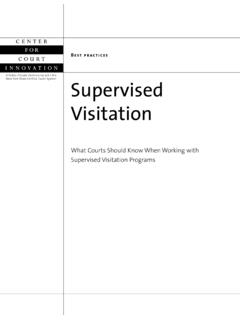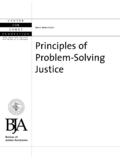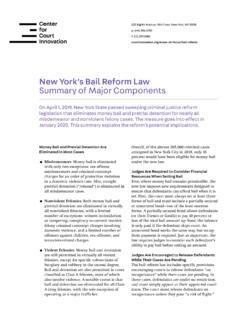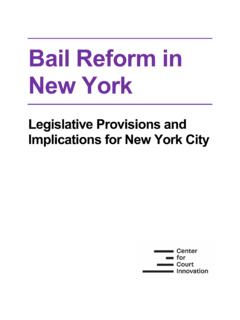Transcription of USING DIVERSION | pg. 1 | …
1 PROBLEM-SOLVING JUSTICEAt the heart of problem-solving justice is the idea of providing key justice systemdecision makers with expanded options with which to respond to criminal behav-ior. When used appropriately, DIVERSION can be a valuable tool for justice officials,helping to take low-level or first-time offenders out of the court system and linkthem to supervised services, such as drug treatment, that address the issuesunderlying criminal behavior. Like problem-solving courts, DIVERSION looks at apopulation of offenders who might be better served outside of a traditional courtsetting, in an effort to reduce future criminality. DIVERSION can work in a number of ways. For example: Charges are not pressed as long as the defendant fulfills the require-ments of the DIVERSION program ( , attends a set number of classesand/or performs a certain number of hours of community service) A charge is brought and suspended until the defendant fulfills programrequirements A defendant enters a guilty plea, which is then dismissed once he or shecompletes the program requirementsBefore starting a problem-solving criminal justice initiative, it would be useful tosee if a DIVERSION program already exists in your jurisdiction and to look at whichoffenders it serves and the types of programs it offers them.
2 If one does exist, itmight make sense to link your problem-solving initiative with the existing program,or at least to see how the programs can benefit and support each other. If one doesn t, starting a DIVERSION program can help offer a richer array of options forthose offenders who could safely the following checklist to plan and implement a DIVERSION starting a DIVERSION program, you need to identify the problems you will betrying to address, as well as determine what resources are available to address them. HAVE YOU What the political climate is in your jurisdiction, with respect to diverting cases from the traditional court process? Does the public understand the benefits of this approach? Do elected officials? USING DIVERSION | pg.
3 1 | practitioner tool was produced as part of the Community-Based Problem-Solving Criminal JusticeInitiative, a project of the Bureau of Justice Assistance that aims to broaden the scope of problem-solvingcourts by testing their approach to wider defendant populations and applying key problem-solving principlesoutside of the specialized court context. The Bureau of Justice Assistance supports law enforcement, courts,corrections, treatment, victim services, technology, and prevention initiatives that strengthen the nation scriminal justice system. The Center for Court Innovation is a non-profit think tank that works with criminal justice practitioners, community-based organizations, and ordinary citizens to develop creativeresponses to public safety problems, aid victims, reduce crime, and improve public confidence in practitioner tool is onein a series to support thedevelopment of problem-solving justice initiatives.
4 Forother documents in theseries, please visit DIVERSION AS PART OFA PROBLEM-SOLVING STRATEGY What kinds of cases are appropriate for DIVERSION in your jurisdiction? What social services are available in your community that might be appropriate? What community service options exist in your community? What, if any, legal benefits would accrue to defendants who successfully complete all DIVERSION program requirements? What, if any, legal consequences would there be for defendants who do not successfully complete all DIVERSION program requirements?ELIGIBILITY REQUIREMENTS: HAVE YOUDEVELOPED A PROCESS Create a risk assessment tool to determine who s qualified for DIVERSION , taking into prior convictions? current charges? clinical factors like homelessness, physical or mental handicaps, disabling conditions, drug use, and mental health issues?
5 INTAKE: HAVE YOU DEVELOPED APROCESS Assess each defendant? Develop a reasonable plan for each defendant based upon this assessment? Match defendants with appropriate services that fit not only the type of offense but the severity of the offense and other risk factors? Consider a community service component for inclusion in the DIVERSION agreement? Inform the defendant of what will be required of him or her to fulfill the DIVERSION agreement?COMPLIANCE: DO YOU HAVE A STANDARDOPERATING PROCEDURE Track all participants in the program? In cases of non-compliance, prosecute diverted cases or request the issuance of bench warrants in a timely manner?ARE YOU Overall compliance rate (total number of participants who fulfill their DIVERSION agreement as a percentage of total number of participants)?
6 Drop-out rate (total number of participants who do not fulfill their DIVERSION agreement as a percentage of total number of participants)? USING DIVERSION AS PART OF A PROBLEM-SOLVING STRATEGY | pg. 2 | READINGJail NAPSA Performance Standards & Goals for Pretrial Release and Short History of the Pretrial DIVERSION of Adult Defendants from Traditional Criminal Justice Processing Part One:The Early Please visit the Center for Court Innovation s Problem-Solving Justice Clearinghouse at or contact Expert Assistance,Center for Court Innovation, 520 Eighth Avenue, New York, NY 10018, Phone: (212) 373-1690, Email: project was supported by Grant No. 2005-PP-CX-K008 awarded by the Bureau of Justice Assistance. The Bureau of Justice Assistance is a component of the Office of Justice Programs, which alsoincludes the Bureau of Justice Statistics, the National Institute of Justice, the Office of Juvenile Justice and Delinquency Prevention, and the Office for Victims of Crime.
7 Points of view or opinions in this document are those of the author and do not represent the official position or policies of the United States Department of Justice.

















